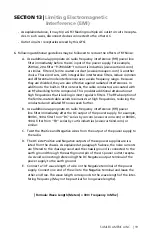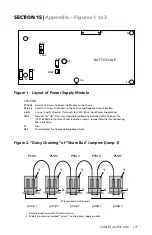
10 | SAMLEX AMERICA INC.
SAMLEX AMERICA INC. | 11
SeCtION 8 |
Installation & Operation
7. Switch
oN the unit by pressing the power oN/off switch to oN position. The switch
will be illuminated confirming that input power is available.
8. A short beep may be generated by the temperature fault alarm circuit on powering
oN the unit . This is normal, please disregard.
9. The
PSM Status LEDs will light and “oN” signal will be fed to the associated drives
of the opto-couplers for remote monitoring / indication through the 25 pin d-sub
connector. As explained under design & principle of operation on page 7, a mini-
mum load current is necessary to operate the current share control circuitry of the
PSMs. It is likely that due to the drift in the pre-set values, the minimum internal
preload current may not be sufficient to provide adequate feedback signal strength
resulting in shut down of one or more modules when no external load is present
(the associated PSM status LED will flash and also, the associated signal for driving
the opto couplers for remote indication will oscillate between “oN” and “off”
conditions). As soon as external load is applied to the unit, the feed-back signal
strength will increase and the PSM(s) that were shut down will also operate nor-
mally.
10. Switch the volt/amp change-over switch to the “volt” position. The voltmeter should
read 14V on no load (please see explanation on page 12).
11. Switch on the D.C. Loads. The output voltage on load should be 13.65V to 13.35V
(please see explanation on page12)
12. Switch the volt/amp meter switch to “amp” position to read the load current. En-
sure that the load current is within the total rated continuous load of the modules
installed.
SeCtION 9 |
Operation of Battery Back-up
WARninG!
The battery should be located in a well ventilated area to safely dissipate
hydrogen gas produced during the charging process.
Please refer to the schematic at fig. A (page 12).
Regulated output voltage of 14.2VDC +/ - 1% from the modules ( measured at screw
terminals S5 and S6, fig.1 is fed to the Positive and Negative DC bus bars and from there
to the output terminals load+ and load- through the isolating Schottky Diode D1. Al-
though the output voltage at the module terminals S5 and S6 (fig.1) or at the common
DC bus bar (before the Schottky Diode D1) is tightly regulated at the preset value of
14.2VDC +/ - 1%, the voltage at the output terminals load + and load - will vary slightly
due to the forward voltage drop of the isolating Schottky Diode D1 and the drop along
the DC bus bar and wiring.










































